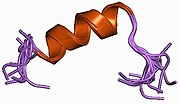SCN8A
Template:PBB Sodium channel, voltage gated, type VIII, alpha subunit also known as SCN8A or Nav1.6 is a protein which in humans is encoded by the SCN8A gene.[1] It is a voltage-gated sodium channel.
The ion channel was discovered by John Caldwell and colleagues at the University of Colorado Health Sciences Center in the rat,[2] and by Miriam Meisler and colleagues at the University of Michigan Medical School in the mouse.[3]
Mutations in this gene have been associated to cases of early infantile epileptic encephalopathy (PMID 24352161). The first known mutation in humans was a missense (c.5302A>G [p.Asn1768Asp]) mutation discovered by Krishna Veeramah and Michael Hammer at the University of Arizona.[4]
An SCN8A Website and Registry has been established at the University of Arizona and approved by the Institutional Review Board for collecting information from families about SCN8A-related epilepsy (http://www.scn8a.net).
See also
References
- ^ "Entrez Gene: SCN8A sodium channel, voltage gated, type VIII, alpha subunit".
- ^ "A novel, abundant sodium channel expressed in neurons and glia". The Journal of Neuroscience. Retrieved 2010-11-22.
{{cite web}}: Italic or bold markup not allowed in:|publisher=(help) - ^ "Mutation of a new sodium channel gene, Scn8a, in the mouse mutant 'motor endplate disease'". Nature Genetics. Retrieved 2010-11-22.
{{cite web}}: Italic or bold markup not allowed in:|publisher=(help) - ^ "De Novo Pathogenic SCN8A Mutation Identified by Whole-Genome Sequencing of a Family Quartet Affected by Infantile Epileptic Encephalopathy and SUDEP". "The American Journal of Human Genetics". Retrieved 2015-09-24.
Further reading
This article incorporates text from the United States National Library of Medicine, which is in the public domain.

